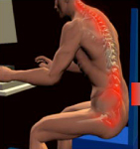Poor posture is the misalignment of the musculoskeletal structure. A body that is out of alignment causes the position of the centre of gravity to shift, which in turn causes stress and overuse/misuse of the muscles and weight-bearing joints as the body adapts to compensate.
There are two different types of misalignments that cause poor posture to develop:
• Structural
• Functional/environmental
Structural misalignments
These are physical misalignments within, or intrinsic to the body. They are permanent and unchanging, with the most common example being a misalignment of the calcaneus and/or talus (bones of the feet) creating a varus or valgus footshape. Another less common example is an anatomical (not functional) short leg.
Structural misalignments are present from birth, although in a minority of cases they can be caused as a result of trauma, serious injury or disease. This means that in most cases, our ability to maintain good posture is compromised before we even take our first steps.
Functional misalignments
These are changes to the alignment of the body caused by external, or environmental factors. Examples include how we sit, what shoes we wear, any accidents we have had and the nature of our occupation.
Functional misalignments are created solely as a result of how we use or misuse our bodies. Repetitive motions, forced postures maintained for long periods of time, continual activity without rest and of course injuries and accidents all contribute to moulding and shaping our structural alignment throughout life.
Interestingly, the development of functional misalignments are controlled in part by structural ones. Because structural problems generate poor posture from the moment we learn to walk, weaknesses in the structure develop which can govern how we choose to sit or what position we find most comfortable.
Differences in assessment
Until now, the most popular cause for poor posture has been functional factors. As a nation overrun with posture-related health problems a lot of money is now being spent on protecting workers from the risks associated with manual handling, prolonged sitting in office environments and repetitive tasks.
Whilst businesses must continue to make money, it is becoming more and more accepted that a proactive approach to managing workers health whilst at work will pay dividends in the long term.
This is a vitally important step forward in the management of posture-related problems caused by environmental factors. The problem is, there are currently not any methods or means in place to identify and control the effects of structural problems on posture.
Paradoxically, without control of structural causes, the beneficial effects of the changes taking place to control risks from environmental causes are being negated.
No matter how adjustable and expensive our ergonomic seat is at work, or how many machines we can get to lift things or carry out repetitive tasks, we are still left having to cope with the effects of poor posture generated by our own bodies.
If we set about understanding and controlling structural causes as well as we have environmental ones, then the long-term health of the nation will benefit.
Call today: 086 076 4307
From NI : 00353 86 076 4307
Email : charlie@ptclinic.ie |

